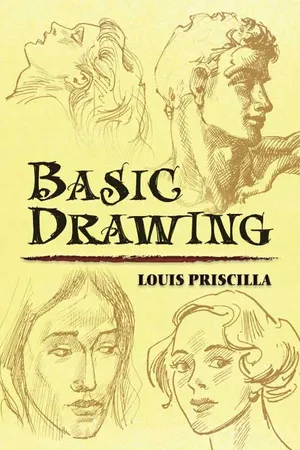
- 128 pages
- English
- ePUB (mobile friendly)
- Available on iOS & Android
eBook - ePub
Basic Drawing
About this book
Unique in its presentation, Basic Drawing teaches by example. Through a profusion of self-explanatory drawings, simple rules of procedure are expertly illustrated for artists, enabling them to build a solid foundation in all aspects of art composition.
Presenting informative facts rather than ideology, the author begins with perspective and progresses to the figure in movement; light and shade; and detailed anatomy such as the head, neck, facial features, back, hips, legs, feet, arms, and hands. Using hundreds of masterful illustrations from his own portfolio, Priscilla continues with drapery, composition, and trees and landscape, including outdoor sketching. A truly all-in-one manual that belongs on every artist's bookshelf, Basic Drawing outlines the fundamental skills of drawing with an effective and powerful simplicity.
Presenting informative facts rather than ideology, the author begins with perspective and progresses to the figure in movement; light and shade; and detailed anatomy such as the head, neck, facial features, back, hips, legs, feet, arms, and hands. Using hundreds of masterful illustrations from his own portfolio, Priscilla continues with drapery, composition, and trees and landscape, including outdoor sketching. A truly all-in-one manual that belongs on every artist's bookshelf, Basic Drawing outlines the fundamental skills of drawing with an effective and powerful simplicity.
Frequently asked questions
Yes, you can cancel anytime from the Subscription tab in your account settings on the Perlego website. Your subscription will stay active until the end of your current billing period. Learn how to cancel your subscription.
No, books cannot be downloaded as external files, such as PDFs, for use outside of Perlego. However, you can download books within the Perlego app for offline reading on mobile or tablet. Learn more here.
Perlego offers two plans: Essential and Complete
- Essential is ideal for learners and professionals who enjoy exploring a wide range of subjects. Access the Essential Library with 800,000+ trusted titles and best-sellers across business, personal growth, and the humanities. Includes unlimited reading time and Standard Read Aloud voice.
- Complete: Perfect for advanced learners and researchers needing full, unrestricted access. Unlock 1.4M+ books across hundreds of subjects, including academic and specialized titles. The Complete Plan also includes advanced features like Premium Read Aloud and Research Assistant.
We are an online textbook subscription service, where you can get access to an entire online library for less than the price of a single book per month. With over 1 million books across 1000+ topics, we’ve got you covered! Learn more here.
Look out for the read-aloud symbol on your next book to see if you can listen to it. The read-aloud tool reads text aloud for you, highlighting the text as it is being read. You can pause it, speed it up and slow it down. Learn more here.
Yes! You can use the Perlego app on both iOS or Android devices to read anytime, anywhere — even offline. Perfect for commutes or when you’re on the go.
Please note we cannot support devices running on iOS 13 and Android 7 or earlier. Learn more about using the app.
Please note we cannot support devices running on iOS 13 and Android 7 or earlier. Learn more about using the app.
Yes, you can access Basic Drawing by Louis Priscilla in PDF and/or ePUB format, as well as other popular books in Art & Techniques d'art. We have over one million books available in our catalogue for you to explore.
Information
PERSPECTIVE
Without the knowledge of perspective, constructive drawing is impossible. Leonardo Da Vinci called it the “bridle and rudder of painting.” Every form, from a grain of sand to a mountain, exists in perspective. It is the first thing a student must learn. Like the alphabet in a language, without it, one would not be able to write. Too many students by-pass this phase of learning. The knowledge of perspective makes it possible to create the illusion that objects and figures are three dimensional on a two dimensional surface such as a sheet of paper, canvas or wall.
There are three basic forms in nature: the square, the circle and the pyramid. Every object fits into these three shapes or a modification of them. The square can be a cigar box or a sky scraper, or any form with six sides. The circle or sphere can be a pea, an observation balloon or a wheel. The pyramid can be a church steeple or the pyramids of Egypt.
The muscles of the human figure can be put into any of these shapes. Knowing the names of the muscles and bones is not sufficient knowledge to draw the figure. If this were so, every good doctor would be able to draw the human figure. One must know the shape of the parts of the body and be able to put them in perspective.
The mere copying of anatomical drawings will not teach one to draw the figure or to create one without the model. There is no other field of study in which students fail in greater proportion than in art, because of by-passing the study of perspective. Its importance cannot be over-stressed. Every great painter understood its laws.
In the following pages I have. tried to show a simple approach to the subject.
With the knowledge of a few simple squares such as a radio, a match box and a package of cigarettes put together becomes a group of buildings. As shown on Page 9, Page 12 and Page 13 two photographs of a shipping department are changed into two cities. The interior of a room is nothing more than looking into a box. If one is able to draw a tube in perspective, it becomes simple to understand the foreshortening of arms and legs of the human figure.
When beginning a drawing or picture, first establish your eye level by drawing a line across your paper. It will correspond to the level of your eyes in relationship with the object or scene that you are drawing. For example, if you are sitting in a chair drawing a model who is standing in front of you, the level of your eyes will be at about the waist of the model. Every form above the eye level will recede downward to the eye level and every part of the model below the level of your eyes will extend upward to the eye level.

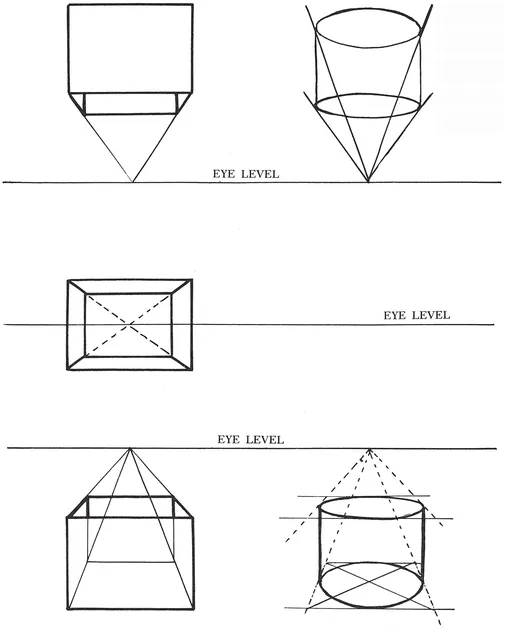
Apply these principles to any square object around you. Place a book in front of you without being able to see the sides but just the front and top and draw it using one point perspective. Try it with a table or chair or any six-sided square, then turn the same objects so you can see three sides – front, side, top using two point perspective.

All objects on this page are in two point perspective.
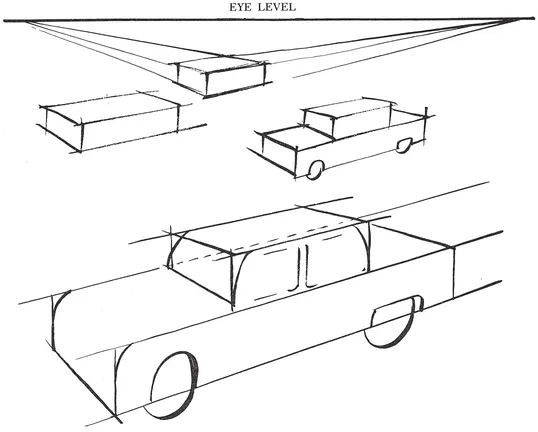
By placing one box over another and rounding the edges you have the basic perspective of a car.

SMALL BOX placed in front of long box gives you a locomotive in perspective.
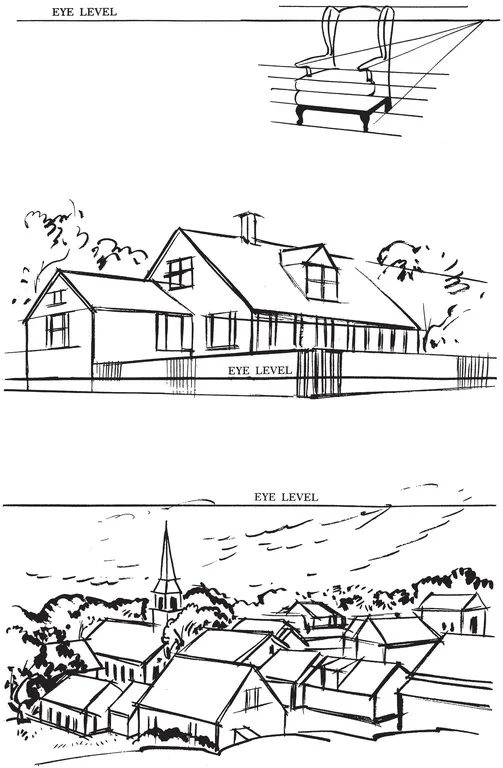
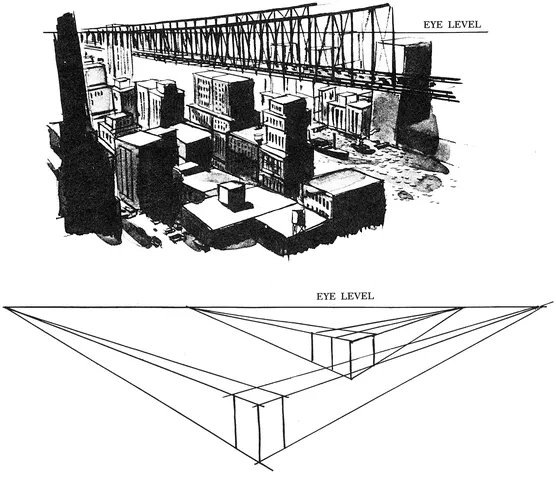
The photographs on this and the following pages are of two shipping departments filled with cartons. With the simple rule of perspective they are turned into two cities.

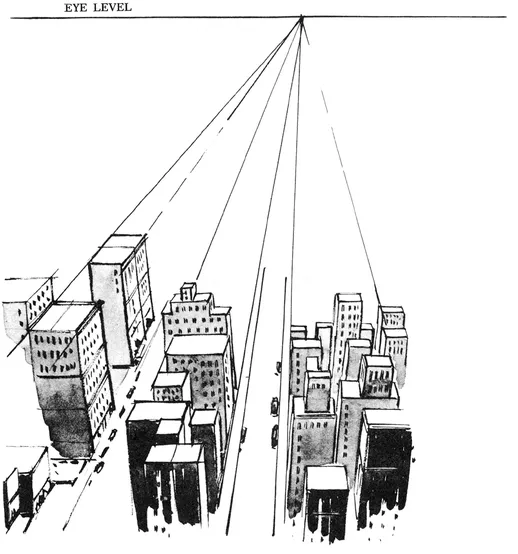

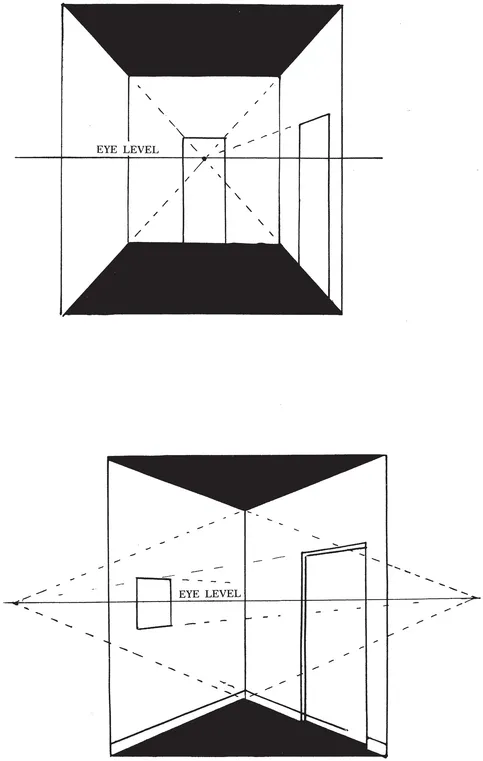
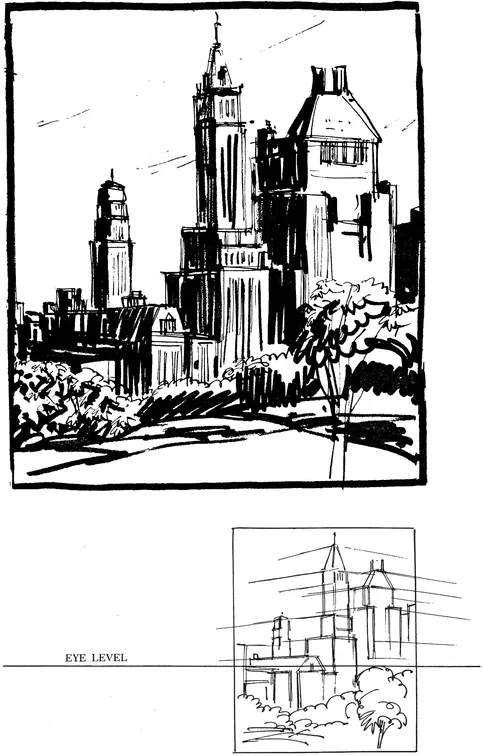
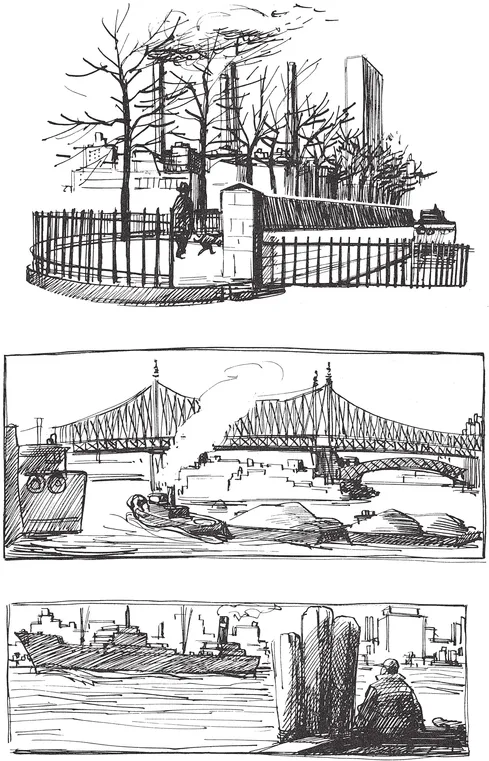
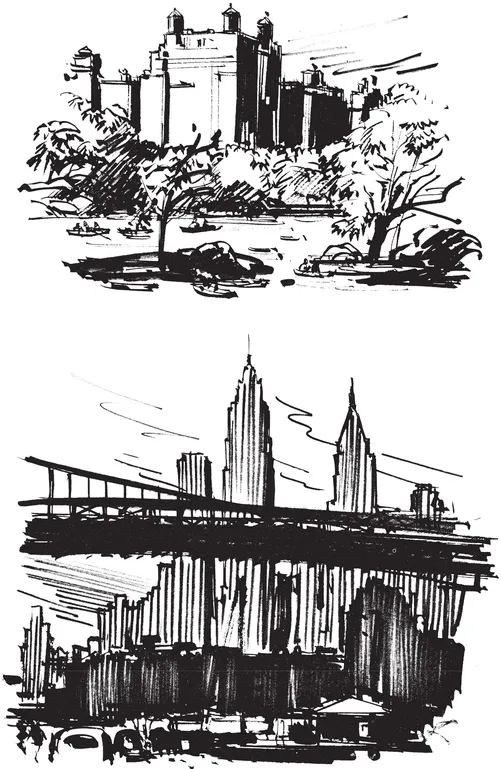
FIGURE IN PERSPECTIVE
In producing a picture with more than one figure, it is necessary to know how the figures in the background diminish in size. This is called the perspective of diminution. When you look at a string of telephone poles, the one farthest away appears smaller than the one nearest to you, even though all the poles are of the same length. Page 20 shows simple examples of how this rule of perspective is applied. On No. 1 the eye level is at the skaters’ knees. The parts of the figure that are above the eye level come down to the eye level and the parts of the figure below the eye level come to the same point on the eye level. Figures...
Table of contents
- Title Page
- Copyright Page
- PREFACE
- Table of Contents
- PERSPECTIVE
- FIGURE IN PERSPECTIVE
- ANATOMY
- FIGURE MEASUREMENT
- FIGURE IN MOVEMENT
- THE HEAD
- MOVEMENT OF LOWER JAW
- FEATURES
- NECK
- TORSO
- BACK.
- HIPS
- LEG AND FOOT
- MUSCLES OF THE LOWER LEG
- ARM AND HAND
- DRAPERY
- COMPOSITION
- TREES AND LANDSCAPE
- OUTDOOR SKETCHING